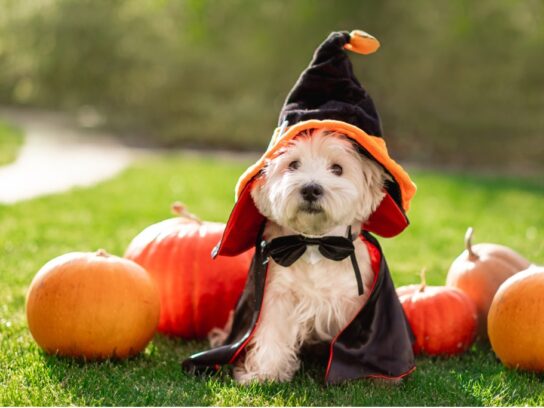
Halloween presents unexpected dangers to pets. The Humane Society offers five tips to keep pets safe during the Halloween holiday season.
Halloween festivities create stress for pets
Before trick-or-treating starts, put pets in a quiet room away from the trick-or-treating activities. Dogs may be safest in their crate to protect them from darting out the front door and give them a sense of safety. Soft music and a treat-filled toy may keep pups occupied and distracted in their crate.
Try handing out candy outside instead of letting trick-or-treaters ring the doorbell. Leave pets home when going out trick-or-treating. They may become excited by the Halloween commotion and dart away or bite someone.
When hosting a Halloween party remember that people in costumes often scare pets, even if they know the person. It is best to put pets in a room away from the party for their comfort and safety.
Halloween treats pose dangers for pets
Many foods typically found in candy, such as chocolate, gum and xylitol are hazardous to pets. Before Halloween and during trick-or-treating, keep candy stored securely away from pets.
Children may not understand the dangers of sharing their candy with a pet. Make sure they know pets may become ill and keep an eye out if the child is too young to understand.
Keep veterinarian and the ASPCA Animal Poison Control Center hotline number handy just in case a pet eats something that’s bad for them. The hotline number is 1-888-426-4435.
Pumpkin can be good for dogs and cats, but too much can cause digestive issues. Rotting pumpkin may harbor bad bacteria so keep carved jack-o-lanterns away from pets.
Halloween decorations may pose threats to pets
Decorations may make cats nervous or frightened, so it is best to limit indoor decorations as much as possible.
Lit candles may create fire hazards and scented candles are toxic to birds. Rubber eyeballs are a choking risk. Glow sticks and face blood are possibly poisonous. Fake cobwebs may choke or entangle pets. Potpourri is toxic to birds.
Pet Halloween costumes
Pets may not be anxious to dress up for Halloween. Masks and hats will not be tolerated by most pets. Minimal pet costumes are suggested.
Make sure the costume is comfortable and allows the pet to move freely. Remove any chewable parts or objects that could come off the costume and present a choking danger.
Remove a costume when pets show signs they are uncomfortable, such as folded down ears, eyes rolling back or looking sideways, a tucked tail or cowering stance.
Protect pets from outdoor dangers
Before night falls, bring pets indoors for their safety. Some pets may run away when frightened by trick-or-treaters.
Make sure all pets are wearing tags with current IDs and their microchip is registered with up-to-date information, just in case a pet does get lost.


Comments are closed.